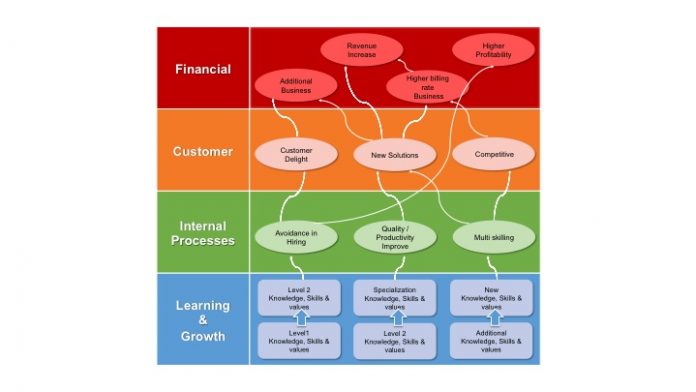
A CEO once asked a CLO, “I spend $X million on the Learning function, but what’s the ROI?”
Can a Learning leader confidently say that there was an impact of, say, $X million on the topline, Y percent increase in profitability, and Z percent reduction in attrition, as a direct result of learning in an organization? The answer is, “Yes.”
Though Kirkpatrick’s Level 4 Kirkpatrick Model: http://www.kirkpatrickpartners.com/OurPhilosophy/KirkpatrickFoundationalPrinciples/tabid/304/Default.aspx and http://www.businessballs.com/kirkpatricklearningevaluationmodel.htm
However, the missing link is to relate and calculate the impact of the learning intervention on profitability and revenue. Some of the challenges in measuring the learning outcomes are:
- The current mindset on measuring learning on soft parameters
- Detailed requirement analysis
- Linking to business outcome
- Converting the outcomes to an actual dollar value
The Balanced Score Card (BSC) framework clearly links the learning interventions to the business outcomes. This approach has four perspectives:
- Learning and growth
- Internal processes
- Customer
- Financial
The first two are internal to an organization, and last two are external. It continuously prompts you to ask how learning interventions impact or change your internal processes. Then it links the changes/impact to customers, who, in turn, impact an organization’s profitability or growth. For example, building a skill internally should reflect in avoidance of hiring externally. While this can bring customer delight, it, in turn, will enable profitability of an organization (see the graphic below). Hence, this approach helps to meet all the challenges in measuring learning outcomes in business terms.
Requirement Analysis
Calculating the profitability or growth of business requires detailed analysis. This is especially so in cases of behavior change, as it takes time to measure. The problem lies in correctly assessing the requirement analysis. We have found that most of the time the requesters are not clear as to what they want, and it is the responsibility of the Learning consultant to pull this requirement from the requester. This can be done by asking simple questions, such as:
- What is the current level of competency or Skill, Knowledge, and values (SKV)?
- What is the expected level of competency or SKV in terms of “ability to do/perform”?
This is means defining both the “as is” and “to be” states. In this process, a pre-assessment plays an important role in performing a gap analysis, which is the crux of the BSC approach.
The questions need to be asked at two levels. At level 1, one needs to clearly know what learning interventions are required. At level 2, one needs to know how these interventions will help the business.

Level 1
This is relatively easy for technical requirements. For example, the candidates have a level of competency in Java or .Net programming and they need to be taken to the next level or they need to learn a different competency, such as a new database. Then the questions need to be articulated in two ways.
- What is the competency required for the next level?
- What should they be able to perform?
The second question is important from the outcome perspective and is needed for properly assessing if the desired level has been achieved. The diagram above illustrates how this can be achieved.
Level 2
The second level is generally trickier, and requesters normally find these questions difficult to answer. It is about how this new competency would help or enable the business. These questions can be articulated in different ways, including:
- Avoidance in Hiring: Would this result in avoidance of hiring new resources? Can these candidates do additional job?
- Addition Business: Would the customer give us additional business? Is this reducing the cost to the customer or does it mean the customer can employ fewer resources?
- Higher Billing Rate: Would the customer be willing to pay a higher billing rate? This is specially so in the case of outsourcing or providing services to the customer.
- Customer Delight: Would a more proficient team bring the customer delight? This also shows the capability of the team to scale up or improve the quality of work.
- Associate Delight: Would this help in retaining the associate or reducing attrition in the organization and how?
Employee Perspective
Another important aspect is associate delight. We need to figure out various learning interventions that provide career opportunities and keep people fruitfully engaged. These programs ideally need to be aligned with employees’ career aspirations and connected with growth opportunities within the organization. These programs also should be aligned to career programs, so that completion of such programs meets the criteria for an associate to be eligible to move into other roles, along with other criteria. The progress made by the participants in such programs can be linked to the performance appraisal and the progress of the same can be tracked through learning management system (LMS).
For example, there could be a score in the appraisal form that is linked to a Competency Index, which must be fulfilled in order to move to the next role or promotion or even to receive compensation. All this needs to be captured to reduce attrition and/or increase employee retention or longevity in the organization, especially for those who are doing well.
ICT companies need to maintain a “bench” (sometimes also called “business waits” or BW) of readily available resources who can be quickly deployed on projects. Normally, the waiting period is two to three months in between the projects. We need to train, re-train, cross-train, up-skill these associates to deploy them in new projects and also to keep them engaged. The value of the training programs can be measured in terms of the number of people trained who have made it to billing opportunities. While it is true that one cannot attribute people moving into billing roles completely to the training programs, but if correctly assessed, some credit (maybe 50 percent) can be attributed to the training programs.
Importance of Assessment
Adopting an effective assessment approach plays an important role in the career development of employees. It’s imperative to baseline people and then recommend them for various types of programs. For example, there could be three levels on a scoring system from 0-5. Levels can be defined as:
Level 1: score of 0-2
Level 2: score 2-3
Level 3: score above 3
This would help in ascertaining the current competency level and help in designing needed programs and building skills at different levels in an organization.
Challenges
Difficulty of Assessment and Measurement of Behavioral Programs
Behavioral programs such as leadership development/sales training intended to bring a behavioral change take time. But unless these programs are tied to intended outcomes, expecting any behavioral change would be farfetched and can result only in temporary, feel- good programs. These programs need to be intensive and based on experiential learning such as role-play, games, simulated environments, etc. Equally important are assessments at regular intervals and continuous learning interventions.
One may have to wait longer for such outcomes—perhaps three to six months. There is no one factor that can be attributed to the successful outcome. For example, if sales have increased by 2 percent, that can be attributed to many factors other than learning programs. It is, therefore, important to investigate what factors led to the increase.
Impact of Domain Programs
As industries are becoming more specialized and new industries are arising, domain knowledge is gaining prominence. In fact, domain knowledge often becomes a key differentiator. Many of the programs are in the e-learning format. While there are assessments at the end of these modules, virtual learning comes with its own challenges for measuring the business impact. We tried to measure the effectiveness of these programs by making assessments more in-depth using a case study approach. These programs also were dovetailed with “Coffee Chat” programs that are more informal. The business outcome could be seen more in terms of improvement in quality; the business outcome should be seen as getting more business from the same customer.
The Proposed Model

Note: For Stage 1, it’s best to develop a Learning Request Form (LFR) that has all the questions such as: current level of competency, required level of competency, number of people to train, industry certification requirements, impact on business, etc.
Conclusion
The old adage, “what gets measured, gets done” is relevant for all learning. With the rapid changes in technology and business environments, the role of continuous learning becomes even more important in driving the business. As Alvin Toffler puts it: “The knowledge workers of today need to unlearn and relearn faster than ever before.” It is, therefore, incumbent on Learning leaders to develop credence with and faith in business leaders who are willing to invest more and more in learning.
Nimish Gupta is a certified graduate of Balanced Score Card from Kaplan & Norton. He has created and successfully implemented this model in Tech Mahindra Computers as Global head of L&D (Tech). Gupta has more than 25 years of experience in industries including defense (Army), media, IT, development, and consultancy. He has more than 10 years of experience in L&D as a trainer, subject matter expert (SME), and global manager. He has introduced mobile learning and a platform for bottoms-up learning. He also has experimented with and introduced new methodologies in peer learning, virtual learning, and assessments. He is a science graduate of St. Stephen’s College, Delhi, Bachelor of Technology, M.E. (Computers) and earned an MBA from XLRI Jamshedpur. Gupta is an avid reader and sportsperson, and he loves music and traveling. He can be reached via e-mail at: g.nimish@gmail.com.




